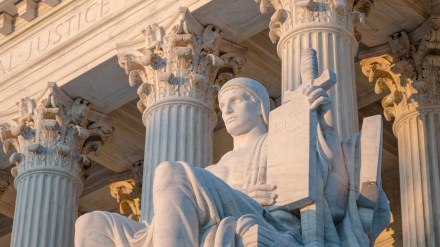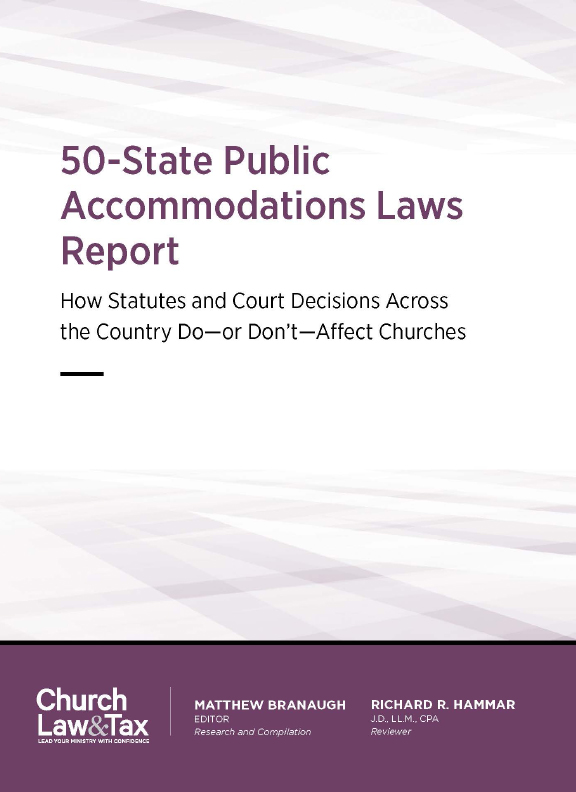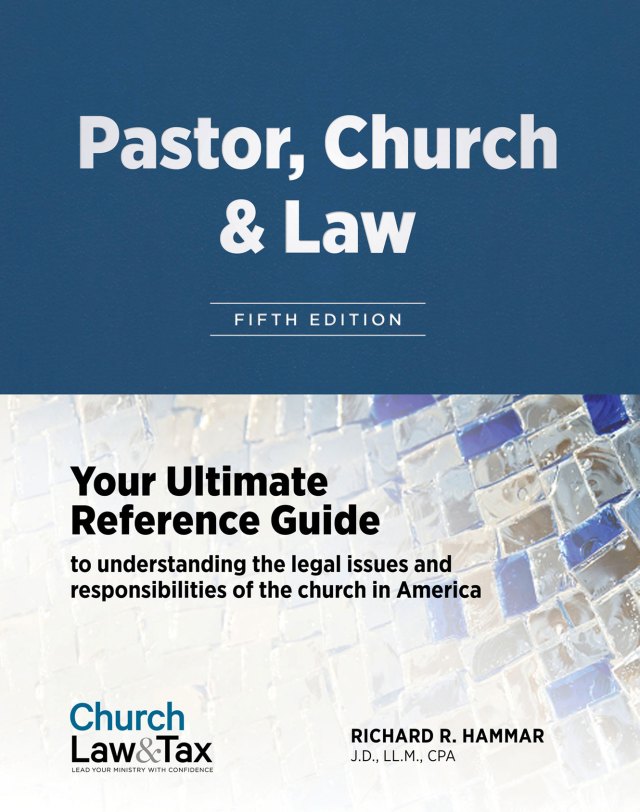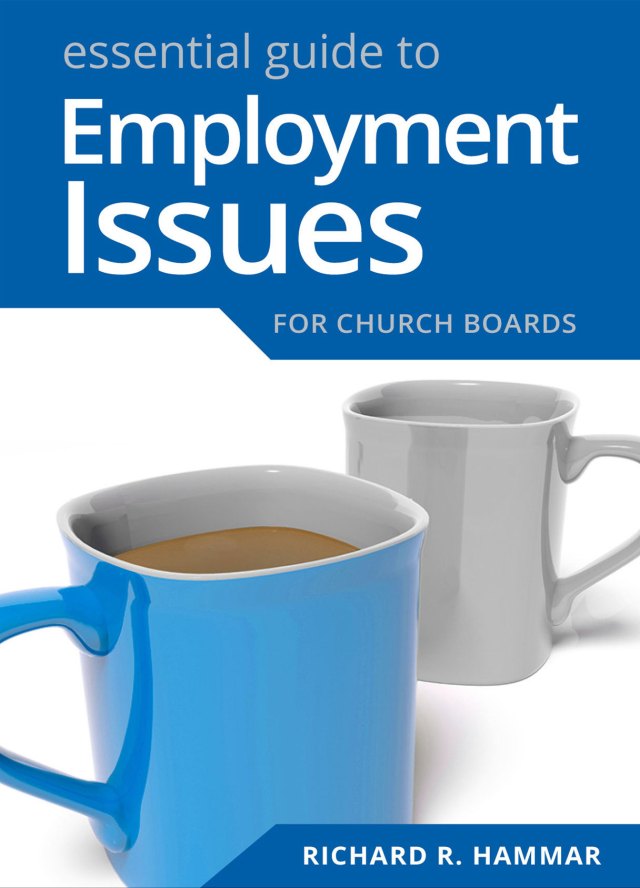Update: Since this ruling, the US Supreme Court has made a number of other decisions that began to reshape religious liberty challenges brought against pandemic-related restrictions. For Richard Hammar’s review of all of these decisions, see “The Sacred and the Secular: Assessing US Supreme Court Rulings on Pandemic Restrictions.”
On May 29, 2020, the US Supreme Court delivered an opinion of the case South Bay United Pentecostal Church et al. v. Newsom. The following article explores the background leading up to the opinion, an analysis of the opinion, and what it might mean for churches nationwide.
Background
On March 4, 2020, California Governor Gavin Newsom proclaimed a State of Emergency as a result of the threat posed by COVID-19 (coronavirus). Two weeks later, on March 19, 2020, the governor issued Executive Order N-33-20, which required “all individuals living in the State of California to stay home or at their place of residence except as needed to maintain continuity of operations of the federal critical infrastructure sectors.”
Executive Order N-33-20 gave some Californians the right to leave their residences, including clergy who were holding services “through streaming or other technologies that support physical distancing and state public health guidelines.”
Seven weeks later the pandemic had, in the governor’s words, “stabilized.” As a result, on May 7, 2020, the governor published his four-stage “California Reopening Plan,” with each stage increasing those persons permitted to leave their residences:
Stage 1: only “critical infrastructure” was exempted.
Stage 2: “lower risk workplaces” like curbside retail and additional factories making previously nonessential “things like toys, clothing . . . and furniture” would be permitted to reopen. Stage 2 also included entities that would reopen at a later date within that stage, such as schools, childcare, dine-in restaurants, outdoor museums, “destination retail, including shopping malls and swap meets,” and office-based businesses where telework is not possible.
Stage 3: “higher risk workplaces” like churches could reopen, along with bars, movie theaters, hair salons, and “hospitality services.” According to California’s Public Health Officer, Stage 3 is for “things like getting your hair cut, getting your nails done, doing anything that has very close inherent relationships with other people, where the proximity is very close.” The Governor’s Order places temporary numerical restrictions on public gatherings to address this extraordinary health emergency. State guidelines currently limit attendance at places of worship to 25 percent of building capacity or a maximum of 100 attendees.
Stage 4: concerts, conventions, and spectator sports could reopen.
The governor predicted that while Stage 2 would begin in “weeks, not months,” Stage 3 would begin in “months, not weeks.”
On May 8, 2020, a church sued the governor and several other state and local officers (collectively, “the State”) in federal court claiming that the Reopening Plan’s decision to place churches within Stage 3 instead of Stage 2 violated the Free Exercise of Religion Clause of the First Amendment. The church asked the court to grant an injunction requiring the State to once again allow churches to conduct in-person services. The court refused, and a federal appeals court concurred with the lower court’s decision. The church appealed to the United States Supreme Court.
The Supreme Court’s holding
On May 29, 2020, a deeply divided Court (5-4) rejected the church’s request for an injunction. Chief Justice John Roberts sided with the Court’s four liberal Justices (Justice Ginsburg, Justice Breyer, Justice Sotomayor, and Justice Kagan) to form a majority. He authored a concurring opinion, which the other four Justices did not join. Though it has no binding effect, Chief Justice Roberts’s comments offer insights into his reasons for rejecting the church’s injunction. Of note:
Although California’s guidelines place restrictions on places of worship, those restrictions appear consistent with the Free Exercise [of religion] Clause of the First Amendment. Similar or more severe restrictions apply to comparable secular gatherings, including lectures, concerts, movie showings, spectator sports, and theatrical performances, where large groups of people gather in close proximity for extended periods of time. And the Order exempts or treats more leniently only dissimilar activities, such as operating grocery stores, banks, and laundromats, in which people neither congregate in large groups nor remain in close proximity for extended periods.
The precise question of when restrictions on particular social activities should be lifted during the pandemic is a dynamic and fact-intensive matter subject to reasonable disagreement. Our Constitution principally entrusts “[t]he safety and the health of the people” to the politically accountable officials of the States “to guard and protect.” Jacobson v. Massachusetts, 197 U. S. 11, 38 (1905). When those officials “undertake to act in areas fraught with medical and scientific uncertainties,” their latitude “must be especially broad.” Marshall v. United States, 414 U. S. 417, 427 (1974). Where those broad limits are not exceeded, they should not be subject to second-guessing by an “unelected federal judiciary,” which lacks the background, competence, and expertise to assess public health and is not accountable to the people.
Justice Kavanaugh’s dissent
Justice Brett Kavanaugh issued a dissenting opinion, which was joined by Justice Neil Gorsuch and Justice Clarence Thomas. (Justice Samuel Alito sided with the church, but did not join the dissenting opinion.) Justice Kavanaugh began his opinion by noting:
I would grant the church’s requested temporary injunction because California’s latest safety guidelines discriminate against places of worship and in favor of comparable secular businesses. Such discrimination violates the First Amendment.
In response to the COVID-19 health crisis, California has now limited attendance at religious worship services to 25% of building capacity or 100 attendees, whichever is lower. The basic constitutional problem is that comparable secular businesses are not subject to a 25% occupancy cap, including factories, offices, supermarkets, restaurants, retail stores, pharmacies, shopping malls, pet grooming shops, bookstores, florists, hair salons, and cannabis dispensaries. [The church] has applied for temporary injunctive relief from California’s 25% occupancy cap on religious worship services. Importantly, the church is willing to abide by the State’s rules that apply to comparable secular businesses, including the rules regarding social distancing and hygiene. But the church objects to a 25% occupancy cap that is imposed on religious worship services but not imposed on those comparable secular businesses.
Justice Kavanaugh noted that to justify its discriminatory treatment of religious worship services, California must show that its rules are “justified by a compelling governmental interest” and “narrowly tailored to advance that interest.” California “undoubtedly has a compelling interest in combating the spread of COVID-19 and protecting the health of its citizens. But restrictions inexplicably applied to one group and exempted from another do little to further these goals and do much to burden religious freedom.” What California needs is “a compelling justification for distinguishing between (i) religious worship services and (ii) the litany of other secular businesses that are not subject to an occupancy cap.”
Justice Kavanaugh concluded:
The church and its congregants simply want to be treated equally to comparable secular businesses. California already trusts its residents and any number of businesses to adhere to proper social distancing and hygiene practices. The State cannot “assume the worst when people go to worship but assume the best when people go to work or go about the rest of their daily lives in permitted social settings.”
California has ample options that would allow it to combat the spread of COVID-19 without discriminating against religion. The State could insist that the congregants adhere to social-distancing and other health requirements and leave it at that—just as the Governor has done for comparable secular activities.” Alternatively, the State could impose reasonable occupancy caps across the board. But absent a compelling justification (which the State has not offered), the State may not take a looser approach with, say, supermarkets, restaurants, factories, and offices while imposing stricter requirements on places of worship. . . . In sum, California’s 25% occupancy cap on religious worship services indisputably discriminates against religion, and such discrimination violates the First Amendment. South Bay United Pentecostal Church et al. v. Newsom 590 U.S. ______ (2020)
What this development means for churches
What is the practical relevance of this case to churches? Consider the following points.
First, the Court’s decision means that churches may not be able to look to the courts for assistance when confronted by a state or local law restricting their ability to conduct worship services.
Second, churches can challenge restrictions on attendance that are stricter than those that apply to comparable secular organizations. Comparable organizations would include those that have similar numbers in attendance for similar periods of duration each week, with similar physical interactions. But churches can be subjected to more stringent limitations on attendance if the totality of their interactions with the public are greater than those of other organizations. In this regard, Chief Justice Roberts noted: “The precise question of when restrictions on particular social activities should be lifted during the pandemic is a dynamic and fact-intensive matter subject to reasonable disagreement.”
Third, Chief Justice Roberts stressed that “[our] Constitution principally entrusts the safety and the health of the people” to the politically accountable officials of the States “to guard and protect.” Jacobson v. Massachusetts, 197 U. S. 11, 38 (1905). When those officials “undertake to act in areas fraught with medical and scientific uncertainties,” their latitude “must be especially broad,” and “where those broad limits are not exceeded, they should not be subject to second-guessing by an unelected federal judiciary, which lacks the background, competence, and expertise to assess public health and is not accountable to the people.”
Fourth, Chief Justice Roberts mentioned the Jacobson case in support of the Court’s decision. In Jacobson, the United States Supreme Court rejected a citizen’s claim that his liberty was invaded “when the State subjects him to fine or imprisonment for neglecting or refusing to submit to vaccination, and that a compulsory vaccination law is unreasonable, arbitrary and oppressive, and, therefore, hostile to the inherent right of every freeman to care for his own body and health in such way as to him seems best; and that the execution of such a law against one who objects to vaccination, no matter for what reason, is nothing short of an assault upon his person.” The Court held:
(I)n every well-ordered society charged with the duty of conserving the safety of its members the rights of the individual in respect of his liberty may at times, under the pressure of great dangers, be subjected to such restraint, to be enforced by reasonable regulations, as the safety of the general public may demand.
The Court also held “real liberty for all could not exist under the operation of a principle which recognizes the right of each individual person to use his own, whether in respect of his person or his property, regardless of the injury that may be done to others.” This case suggests, though not conclusively, that safety and health regulations, such as compulsory vaccinations, supersede religious liberty.
Fifth, church leaders that continue to hold worship services in contravention of state or local restrictions must understand that in doing so they are exposing their congregation to possible risks and liability should one or more persons become infected with the COVID-19 virus. These risks include:
- Personal liability of church board members if their decision to ignore government mandates and recommendations is deemed to constitute gross negligence. Most states have enacted laws limiting the liability of church officers and directors. The most common type of statute immunizes uncompensated directors and officers from legal liability for their ordinary negligence committed within the scope of their official duties. These statutes generally provide no protection for “willful and wanton” conduct or “gross negligence”—the same standard typically used as a basis for punitive damages.
- Punitive damages are monetary damages that a jury can award when a defendant’s conduct is grossly negligent or reckless. This does not necessarily mean intentional misconduct. Punitive damages often are associated with reckless conduct or conduct creating a high risk of harm. The United States Supreme Court has noted that the goal of punitive damages is “deterrence and retribution,” that is, “to further a state’s legitimate interests in punishing unlawful conduct and deterring its repetition.” State Farm Mutual Automobile Insurance Company v. Campbell, 538 U.S. 408 (2003).
- It is important for church leaders to understand that reckless inattention to risks can lead to punitive damages, and that such damages ordinarily are not covered by a church’s liability insurance policy. This means that a jury award of punitive damages represents a potentially uninsured risk. As a result, church leaders should understand the basis for punitive damages, and avoid behavior that might be viewed as grossly negligent.
To learn more about how federal and state courts decide religious freedom cases, and to understand which states have state RFRAs or other religious freedom laws, check out the 50-State Religious Freedom Laws Report, a new downloadable resource from Church Law & Tax.





